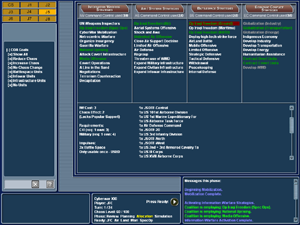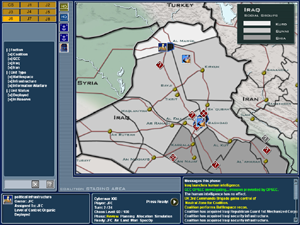DESIGN NOTES
by designer Joseph Miranda
CYBERWAR XXI - Joint Theater Commander (CW XXI-JTC) reflects many of the changes in US military doctrine and execution of the last decade as well as extrapolating trends for the upcoming decade. It shows how modern war must be fought on multiple levels.
The concept behind the game’s systems is that everything in modern warfare affects everything else. Cascading effects function across all the levels of the game. These are primarily in the form of shifts in the Information Warfare indexes on the J2 screen Nexuses. This is complex and difficult to manage. Collateral damage usually causes a shift in support away from the force that inflicted it. However, a well timed military strike can also undermine enemy morale.
Information warfare assets represent task organization by mission type rather than table of organization units per se. A political warfare cadre might represent a PSYOP company, or embedded media, or special operations teams which are trained in influencing the public with media. This simplifies the game and also provides a “readout” of the various capabilities they possess rather than having to deal with a wide range of units which essentially do the same thing.
The Joint Operations system for the game follows the general course of US joint operations doctrine. The basic concept is that participants playing the role of Component Commanders have to cooperate to gain a “joint” victory. Each participant has access to J1-J8 officers that are AI controlled (as are the OPFOR and other game entities). The system allows players to access information and make decisions by using established military staff procedures.
Winning the Battles, Losing the War
Most game actions generate cascading effects. For example, combat causes a game subsystem checks for the following factors: who won or lost the battle; the size of the battle; collateral damage; etc. The system uses a matrix to determine the possible wider psychological effects on audience outside the immediate theater of operations. This represents the impact that military operations have on people either through direct contact or by amplification through the media. This results in shifts to the levels of Infowar Dominance in the various (J2 screen) nexuses. You can win a battle and thereby increase your Dominance of friendly groups owing to a rise in friendly morale. But, at the same time, your actions may also increase the enemy’s Dominance of his own as well as otherwise neutral groups. Generally, the more force you use, the greater the chance of an extreme cascading effect as a result. You can more directly affect Infowar Dominance of various Nexuses by targeting them with Infowar operations. For example, you can direct your political warfare assets to conduct PSYOP versus an enemy Nexus.
Systems Warfare
One of the premises of the game is that certain types of infrastructure are needed to maintain other types of infrastructure. For example, power generation is needed to maintain industrial infrastructure. Certain types of Courses of Action (COAs) and military operations require the player to have certain types of infrastructure in place. Attacking (or capturing) enemy infrastructure will undermine the enemy’s ability to operate. The negative side is that if you destroy the enemy’s infrastructure you will not be able to use it when you capture it.
Joint Operations
CW XXI-JTC requires players to cooperate in an operational-strategic setting. All the players are part of the same team. But they each have different force mixes with which to fulfill their joint mission. Players run a campaign, i.e., the operational level of war. They also have access to various strategic assets, such as national level intelligence and civilian agency support. They often have to “think big” in order to mobilize their forces. At the same time, they have to accomplish objectives within certain region-specific contexts. Each Component Commander will be competing for the same resources. The Joint Force Commander needs to ensure each of his subordinate component commanders has the units and resources he needs to complete his mission.
SCREENSHOTS

J5 – PLANNING
The Joint Force Commander and his four Component Commander discuss and select operational Courses of Action to meet overall mission objectives.

J6 - POLITICAL INFRASTRUCTURE
Used to assign covert operations to both military and InfoWar assets.
JOSEPH MIRANDA BIO
Joseph Miranda specializes in the design of cutting edge simulations of cyberwar, information warfare and the revolution in military affairs that emphasize the complex interrelationships between military, political, economic and other "soft" factors.
As Editor of Strategy & Tactics, an award-winning international military history and simulations magazine, Mr. Miranda was responsible for the development of new concepts in military warfighting, research and analysis. Some of his designs published by S&T include: Holy War: Afghanistan (the Soviet war against the Resistance), Nicaragua (asymmetrical warfare in Central America), Cybernauts (cyberwar), and Invasion: Taipei (China vs. Taiwan in the near future).
More recently, Mr. Miranda has been a consultant to computer gaming companies and the government on simulations and information/cybernetic warfare as well as counter-terrorism. Simulation tools based on Mr. Miranda's concepts and designs include CYBERWAR XXI for AFOSR and CRISIS XXI for DARPA.
Mr. Miranda’s career includes serving as an officer in the United States Army where he taught psychological operations and other unconventional warfare subjects at the JFK Special Warfare Center. He is a university lecturer in criminology, and an author. In addition to designing over 100 published simulations and writing dozens of articles on military history, political warfare and cybernetics, Mr. Miranda is also a frequent guest speaker at Defense Department conferences on simulations and cybernetic warfare.